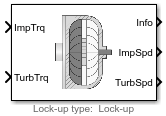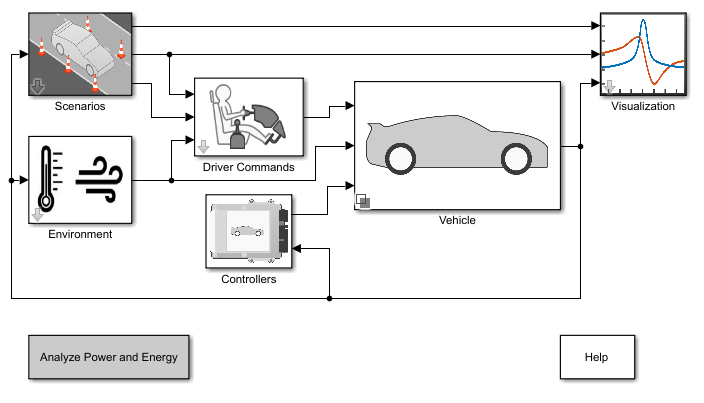Torque Converter
Three-part torque converter consisting of an impeller, turbine, and stator
Libraries:
Powertrain Blockset /
Transmission /
Torque Converters
Description
The Torque Converter block implements a three-part torque converter consisting of an impeller, turbine, and stator with an optional clutch lock-up capability. The block can simulate driving (power flowing from impeller to turbine) and coasting (power from turbine dissipated in torque converter hydraulic fluid).
You can specify torque converter characteristics:
Speed ratio — Ratio of turbine angular speed to impeller angular speed
Torque ratio — Ratio of turbine torque to impeller torque
Capacity factor parameterization — Function of input speed or input torque
Optional clutch lock-up configurations include:
No lock-up — Model fluid-coupling only
Lock-up — Model automatic clutch engagement
External lock-up — Model clutch pressure as input from an external signal

Dynamics
Based on the clutch lock-up condition, the block implements these friction models.
| If | Clutch Condition | Friction Model |
|---|---|---|
| Unlocked | ||
| Locked |
Tf = Ts |
To model the rotational dynamics if the clutch is locked, the block implements equations.
The rotational velocity represents both the impeller and turbine rotational velocities.
To model the rotational dynamics if the clutch is unlocked, the block implements equations.
To approximate the torque multiplication lag between the impeller and turbine, you can specify the parameter Fluid torque response time constant (set to 0 to disable), tauc [s].
Power Accounting
For the power accounting, the block implements these equations.
| Bus Signal | Description | Variable | Equations | ||
|---|---|---|---|---|---|
|
|
| Applied impeller power | Pimp | |
PwrTurb | Applied turbine output power | Pturb | |||
|
| PwrDampLoss | Mechanical damping loss | Pdamploss | ||
PwrFluidCplingLoss | Heat loss to transmission fluid | Pflloss | |||
PwrCltchLoss | Clutch slip power loss | Pcltloss | |||
|
| PwrStoredImp | Rate change in impeller rotational kinetic energy | Pstrimp | ||
PwrStoredTurb | Rate change in turbine rotational kinetic energy | Pstrturb | |||
The block implements equations that use these variables.
Frictional torque | |
Kinetic frictional torque | |
Static frictional torque | |
Applied input torque | |
Impeller reaction torque | |
Externally applied turbine torque | |
Torque conversion capacity factor | |
Torque ratio | |
Impeller rotational shaft speed | |
Turbine rotational shaft speed | |
Impeller rotational inertia | |
Turbine rotational inertia | |
Impeller rotational viscous damping | |
Turbine rotational viscous damping | |
Effective clutch radius | |
Annular disk outer radius | |
Annular disk inner radius |
Examples
Ports
Inputs
Output
Parameters
Extended Capabilities
Version History
Introduced in R2017a

